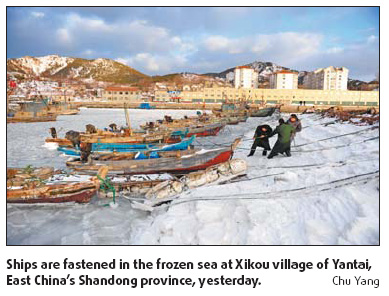Society
Sea ice threatening ships, fishermen
By Chen Jia in Beijing, Zhang Xiaomin in Dalian and Ju Chuanjiang in Yantai (China Daily)
Updated: 2010-01-14 09:07
 |
Large Medium Small |

The worst sea ice in 30 years is threatening shipping and the livelihoods of fishermen on China's eastern coast.
Floating chunks of ice off the eastern coast will continue to increase until the temperature warms between Saturday and next Tuesday, according to China's National Marine Forecasting Station yesterday.
"The sea ice is about 60 nautical miles (110 km) off the coast of Liaodong Bay," Liu Yu, the station's chief forecaster, told China Daily yesterday.
The floating chunks of ice extended up to 44 km in Baohai Bay, 48 km in Laizhou Bay and 41 km in the northern Yellow Sea, he said.
Offshore drilling platforms have been threatened by the ice, with some in Liaodong Bay having stopped working.
Around 500 fishing boats have been caught in the ice in Laizhou Bay, local fisherman Sun Wenliang told China Daily yesterday.
"We can't do anything about it, and we don't have an icebreaker," he said.
In Jinan, capital of Shandong province, the local government has helped around 2,000 fishing boats return safely.
By next week the thickness of the ice could measure up to 40 cm, the station said.
Liu noted that the worst sea ice in the past 30 years began to appear in early January along the coastline of the Bohai Sea and northern Yellow Sea as "cold fronts pushed the temperature down to minus 10 C and below".
"The number of warming trends since November has been lower than other years, and that's why the thickness of the sea ice could reach up to 40 cm," he said.
With another cold front expected after next Tuesday, more ice might develop along the coastline, he said.
"But we might miss the best fishing time for small fish and mollusks, which starts from March 10 this year," said Wang Hongjian, a 62-year-old fisherman in Xiaoheishi Town of Liaoning province.
The best fishing time is March to May, and September to October in Bohai Bay, he said.
The death toll from the severe cold weather rose to six yesterday with millions of others affected.
In North China's Inner Mongolia autonomous region, two deaths had been reported as of yesterday. Police said a student froze to death when he got lost after school in windy weather. Police were still investigating the other case.
In Northwest China's Xinjiang Uygur autonomous region, four people have been killed by avalanches and another froze to death.
More snow was forecast until tomorrow in most parts of Tibet, Xinjiang and Inner Mongolia with temperatures falling by 6 to 8 degrees, according to China's Central Meteorological Station.
The station forecast on Monday that the cold weather would continue in North China and some southern regions for the next 10 days.
Xinhua contributed to the story











